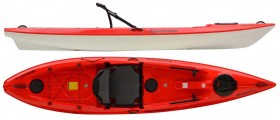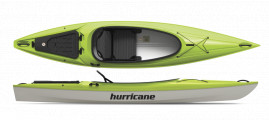Eastern North Carolina is home to saltwater marshes, inland swamps, warm-water millponds and many other fantastic places to explore. With this complex network of slow-moving waterways, it’s no surprise that some of the most formidable recreational kayak builders call this region home. Hurricane kayaks is one of them, although you don’t need to live on the iconic coastal plain to enjoy paddling one of their kayaks.
Hurricane kayaks was founded in 1998 by a group of paddlers who set out to make lightweight boats that recreational kayakers would love. They landed on the thermoforming construction method because it produces light, strong and beautiful kayaks. Thermoformed kayaks have the stiffness and performance of more expensive composites like fiberglass, while retaining the durability and affordability of plastic kayaks.
Hurricane builds recreational sit-inside and sit-on-top kayaks for all skill levels of paddlers, focusing mainly on the types of kayaks that are best for day outings. These aren’t your budget, mass-produced recreational kayaks. Hurricane kayaks’ sealed bulkheads (interior walls within the hull that ensure flotation if the kayak swamps) add a layer of safety that isn’t found on most big-box store kayaks, and their candy-colored glossy finish is a treat for the eyes.
For paddlers concerned about weight, Hurricane builds some of the lightest recreational kayaks available. Casual anglers also love the spacious designs and fish-friendly features of Hurricane kayaks.
This article will help you choose the best Hurricane kayak for your paddling goals. We’ll provide an overview of their lineup, as well as links to learn more about specific models in our Paddling Buyer’s Guide. We’ve also got some tips for buying used kayaks and answers to common questions.
Top picks: Best Hurricane kayaks for 2024
The following Hurricane kayaks have received the highest star ratings by reviewers in our Paddling Buyer’s Guide. See and review all Hurricane kayaks here.
Best Hurricane Kayaks
Shop Hurricane kayaks
Follow the links below to start viewing specifications, prices and reviews of specific Hurricane kayak models in our Paddling Buyer’s Guide. This comprehensive guide features every Hurricane kayak model on the market, along with comparable boats to save you the trouble of jumping from website to website. Filter by type of kayak, or where to buy.
Shop by type
Shop by store
Shopping for a used Hurricane kayak?
If you’re able to track down a secondhand Hurricane kayak, you can score a gently used, high-end kayak for a similar price to that of a new, lower-end polyethylene kayak.
How to find used Hurricane kayaks
Find an outfitter who stocks Hurricane kayaks for rentals. Renting the kayak for an outing is an excellent opportunity to assess fit, comfort and performance before you commit to a purchase. Many outfitters frequently turn over their rental fleet, selling off some of their older models at the end of the paddling season.
The easiest way to start searching for used kayaks is by sifting through online classifieds. You can check the more general ones like Craigslist, Facebook Marketplace or Kijiji using general search terms like “12-foot kayak”. Consider setting up an email alert for a more specific term like “Hurricane kayak” or even the exact model you’re looking for. Also, check out niche classifieds like PaddleMonster or MEC Gear Swap.
Check the condition of the kayak
Say your “Hurricane kayak Craigslist” search turned up a potential winner. What are some important questions you should ask the seller?
For starters, understanding how they used the kayak will reveal the boat’s capabilities. Most passionate paddlers will be happy to regale you with their kayaking tales and where the boat has taken them. Or possibly they only took the kayak out a handful of times and realized it wasn’t the sport (or the kayak) for them. Since then, it may have sat collecting dust. Ask the owner how and where it was stored.
Although Hurricane kayaks have a UV-resistant coating, continuous exposure to direct sunlight for extended periods can make the plastic brittle, weakening the hull. Look for used kayaks that have been stored indoors on a rack, in a garage or at least off the ground in the shade.
The Trylon ABS plastic laminate used to make Hurricane kayaks resists impact and abrasions well, but every material has its limits. Fortunately, most minor cracks are easily repairable. Hurricane details the steps of these repairs on their website, and you don’t need to be a professional to carry them out. Similarly, minor damage or wear to outfitting like seats, seat backs, foot pegs and bungees is often easy to fix with replacement parts or even supplies from your local hardware store.
How much is a fair price?
What is a fair price for a kayak? Unfortunately, there’s no simple answer. Interest in paddlesports has surged over the last two years, driving up the demand, and in turn, the prices of used kayaks.
Kayaks hold their value well, and expect to pay anywhere from 50 to 80 percent of the new sticker price. In the peak of summer, you might need to act quickly to get the kayak you want. This could mean paying top dollar for your dream kayak. Otherwise, waiting until the end of the season usually brings the prices (but also, usually, the selection) down.
For more tips on what to look for when selecting a used kayak, read our article How To Buy A Used Kayak.
Hurricane kayak buying advice
Hurricane kayaks are best suited to paddlers who want to go on day-long or half-day outings on sheltered waters. These kayaks are stable, but still track (move straight) extremely well and are easy to turn. The large cockpit found on most Hurricane sit-inside kayaks makes for easy entry and reduces any confining feelings that some newer paddlers experience. It also makes these kayaks suitable for bringing along a small child or four-legged companion, or casual kayak fishing.
Two of the major advantages of Hurricane kayaks are the thermoformed ABS construction and the integrated bulkheads on all of their sit-inside kayaks. Thermoforming is a process by which sheets of ABS-acrylic plastic laminate are heated and formed around the kayak mold. This technique uses less (and lighter weight) material and allows for more refined shapes (and a shinier, eye-catching finish) as compared to rotomolded kayaks.
Hurricane’s proprietary Trylon ABS material makes the kayaks strong but light, while the bulkheads (interior walls within the hull) make them buoyant and safe to use further from shore. Additionally, Hurricane’s Trylon bulkheads have a stronger bond with the surrounding hull and are much more durable and less likely to form leaks than the foam bulkheads used in most polyethylene kayaks.
Hurricane categorizes their kayak offerings as Recreational, Sit-on-top, Day Touring and Fishing. Within these categories are some different models and sizes to choose from as well.
Recreational kayaks
Recreational sit-inside kayaks comprise the bulk of Hurricane’s lineup. Although they are stable and easy to use, these aren’t exclusively beginner boats. The kayaks’ short lengths and light weights appeal to anyone who doesn’t want to lug a 17-foot sea kayak out for a quick paddle.
Their multi-chine hulls have a series of flat surfaces and defined edges, allowing more experienced paddlers to confidently and securely put the kayak on edge by subtly shifting their weight, thus turning more efficiently. The ABS bulkheads on these boats give them inherent buoyancy even when the cockpit fills with water, making them among the safest recreational kayaks you can buy.
Hurricane kayaks currently makes the Prima and Santee recreational kayaks in 11- and 12-foot lengths, along with a 14-foot tandem. The Sport models of these kayaks boast an oversized cockpit to accommodate extra gear, a pet or even a small child passenger. Choose a non-Sport model for a more snug fit. These kayaks are outfitted with comfortable foam thigh braces under the cockpit and adjustable foot pegs.
The Prima models have an integrated keel for better tracking (ability to travel in a straight line), and a removable frame seat that doubles as a beach chair. This adds about five pounds more weight than the Santee, but you can take the seat out if you’re loading the kayak onto a rack or trailer. The Santee 140 Tandem has an open cockpit area for an almost canoe-like ride.
Sit-on-top kayaks
Hurricane kayaks’ Skimmer models are among the lightest sit-on-tops on the market, thanks to their Trylon ABS construction. Choose from a variety of sizes ranging from 10 to 14 feet long, including a tandem option. Aside from their lightweight builds, the dry storage hatches of these sit-on-tops set them apart from others. On each Skimmer, you’ll find a roomy bow hatch for storage, with smaller center and stern hatches on longer models.
Hatch sizes vary by boat length, but are at least 8” in diameter to fit bags, fishing rods or anything else you want to take for a day on the water. The Skimmer 116 First Class has a frame seat instead of Hurricane’s standard seating. This seat sits slightly higher on the kayak for a better vantage point when birding or fishing.
Day touring kayaks
Hurricane’s Sojourn 135 is a great option for small- to medium-size paddlers looking for something with a bit more speed and storage capacity than a recreational kayak. This day touring model has cargo space in the spacious bow and stern hatches for a weekend camping trip.
The Sojourn hull shares the reassuring stability of Hurricane’s recreational kayaks, while stretching the waterline for better speed and efficiency. Best of all, it’s among the lightest day touring kayaks available, at just 45 lbs. Read an in-depth review of the Sojourn here.
Fishing kayaks
Hurricane’s two recent fishing kayaks, the SweetWater 126 and the Skimmer Angler DLX, are currently out of production while the company ramps up production on its bestselling recreational models to meet unprecedented demand. However, you may find old stock of these fishing kayaks, or track one down on the used market. Both are lightweight sit-on-top styles with stable hulls and all the fishing features you need, including rod holders, tank well, tackle storage and gear accessory tracks. The SweetWater 126 also comes with a frame seat for optimal vantage point while casting and stalking fish.
Use this as a start, and remember that online research will only get you so far. The best advice we can offer is to always test paddle before buying any boat. The more time you can spend on the water in a similar style of kayak, the better the purchasing decision you will make.
Here are answers to some of the most common questions about Hurricane kayaks.
-
Are Hurricane kayaks durable?
The lightweight acrylic-ABS material Hurricane uses for their thermoform kayaks is quite strong and durable. This material can handle regular impacts and abrasions just as well as a heavier rotomolded polyethylene kayak.
Damage to a Hurricane kayak is most likely to occur from over-tightening the kayak when securing it to a trailer or roof rack. Thermoform kayaks are susceptible to cracking when temperatures are below zero; always store on a rack, under shelter during the winter.
-
How much does a Hurricane kayak weigh?
The Prima 110 Sport is Hurricane’s lightest kayak at 36 pounds, and the Skimmer 140 sit-on-top is the heaviest solo kayak offered at 52 pounds. Compared to polyethylene kayaks, Hurricane kayaks are significantly lighter than most.
-
Hurricane kayak dimensions
You can view the specific dimensions of each Hurricane kayak in the Paddling Buyer’s Guide. Their kayaks range in length from the 10’6” Skimmer 106 to 14-foot tandems like the Santee 140.
-
What are Hurricane kayaks made of?
Hurricane kayaks are made with their proprietary Trylon ABS plastic laminate. In the thermoforming process, sheets of this Trylon material are heated and pressed into a mold. One sheet forms the top of the kayak, and another makes the hull, giving them a glossy, two-tone aesthetic. The two pieces are then chemically bonded together for a watertight seal. The main advantages of this material are its light weight, durability, shiny finish and affordable cost.
-
How much does a Hurricane kayak cost?
Hurricane kayak prices start at $1,000 USD. These premium recreational kayaks range upwards of $1,500 USD depending on the model.
-
Hurricane kayak warranty
New Hurricane kayaks come with a three-year limited warranty covering defects in materials and workmanship. Warranty claims can be processed through the dealer you purchased the kayak from.
-
Where to buy Hurricane kayaks
Most Hurricane kayak dealers are east of the Rockies in Canada and the USA. There are a select few on the West Coast as well. Use their dealer locator to find one near you.
-
Where are Hurricane kayaks made?
Hurricane kayaks are made in North Carolina.
-
Problems with Hurricane kayaks
Hurricane kayaks, like many other boat builders, are experiencing a surge in demand coupled with delays in raw materials due to supply chain issues. For that reason, the company has temporarily paused production of certain kayak models, streamlining their offerings to meet the demand for the most popular boats. Some models may be difficult to track down for the time being and may need to be pre-ordered through a dealer for next season.
Compare Hurricane kayaks
-
Eddyline vs Hurricane kayaks
Based on the West Coast, Eddyline is a well-established producer of American-made thermoformed ABS kayaks. Compared to Hurricane kayaks’ mostly recreational lineup, Eddyline has more touring-oriented options like their Sitka and Fathom kayaks, all of which are longer than 13.5 feet. They feature retractable skegs (or fins under the hull) for enhanced tracking, a common design element on touring boats. Like Hurricane, Eddyline’s recreational kayaks all have bow and stern bulkheads (on sit-inside models) for superior safety.
Choose an Eddyline kayak if the touring models catch your eye. Hurricane’s Sport models boast a larger cockpit opening than Eddyline’s recreational kayaks, making them a good choice if you’ll be paddling with your pup or if you have limited mobility but want a sit-inside kayak. Hurricane kayaks are slightly less expensive than Eddyline kayaks and comparable in quality. Try either brand if you are looking for a high-performing recreational kayak.
Hurricane kayak reviews
Kayak reviews from Paddling Magazine staff will give you more insight into a boat’s performance than simply reading specifications and marketing. Follow the links below, and learn more about the strengths and weaknesses of each Hurricane kayak.












